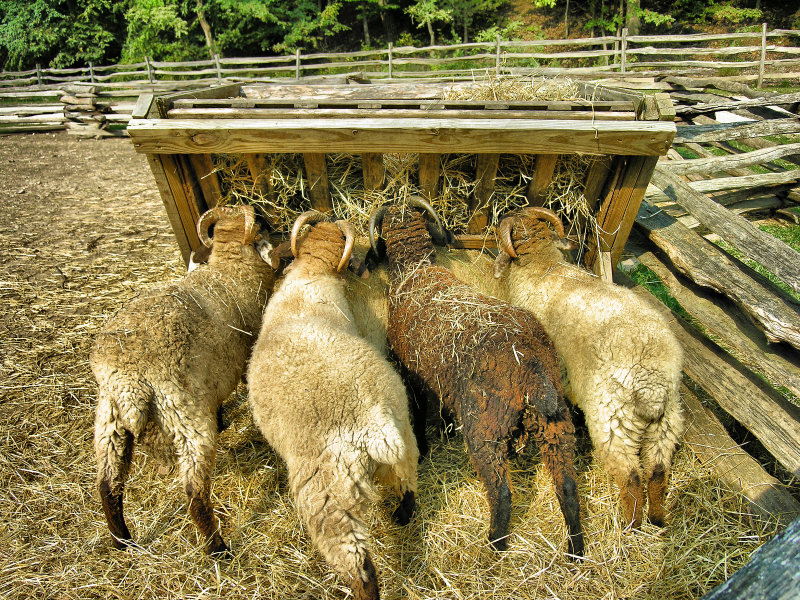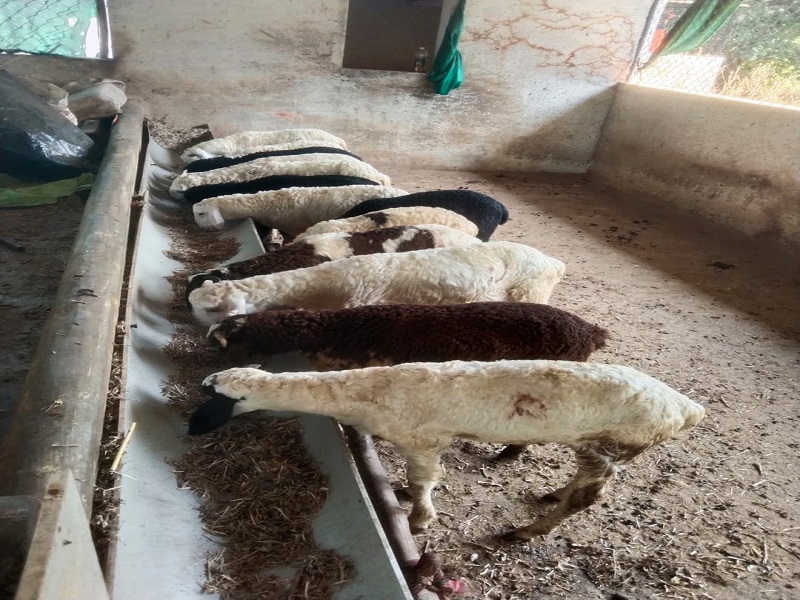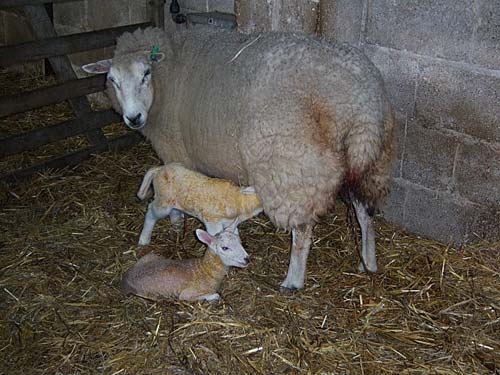Sheep Feeding
Grazing – better thrive -on stubble after harvest
- Highly resistant- water deprivation.
- Bifid upper lip.
- Consideration for fleece.


Reducing over fattening of ewes
- Over-fattening will result in excessive fat deposition resulting in reduced fertility
- A good shepherd should watch for over-fattening at least one and a half to two months before the onset of breeding season.
- The over-fat ewes may be gradually brought down to the desirable lean condition, by reducing the ration and by exercising.
- The farmer should constantly check and keep the ewes in condition for flushing by mild reduction in feed and providing exercise.
Flushing
- Improving the nutritional status of ewes during 3-4 weeks prior to mating is known as ‘flushing’. Nutrition and body condition of the ewes prior to putting them to ram are important.
- Flushing will have effect only if the ewes were in declining phase of nutritional availability. Ewes in better body condition will produce more lambs and thus the flushing of leaner ewes will increase the fertility by way of increased incidence of oestrus and increased ovulation rate.
- To obtain increased lambing rate, the breeding ewes, 4-6 weeks prior to their being bred, should be supplemented with 250g of concentrate mixture or 500 g of good quality legume hay per head per day.
- It also has the effect of bringing the ewes into heat a more nearly the same time, resulting in a more uniform lamb crop.
- Besides, flushing also increases the lambing rate and incidence of multiple births in the flock.
- Different flushing rations are furnished below and any one method can be followed depending upon the availability of feed resources.
Suggested flushing rations
- A good mixed pasture of legumes and grasses,
- A grass pasture plus 150 g of wheat bran per head per day,
- Grass pasture plus 250 g of grains and 450 g of oil cakes,
- Legume hay full fed plus 100 g of wheat bran and 150 to 200 g of grain and
- Green fodder at the rate of 10 per cent of body weight and 150-200 g of concentrate per head per day.
Pregnant Ewes
- The foetus makes two-thirds of its total growth during the last 6 weeks of pregnancy. The consequences of under-nutrition in late pregnancy are reduction in lamb’s birth weight, poor milk production and poor lamb survival.
- Good feeding during gestation is the keystone for a healthy strong lamb crop
- It decreases the probability of ewes disowning their lambs as a result of exhaustion and weakness.
- Under-nutrition may also result in occurrence of pregnancy toxaemia which results in collapse and possible death of the ewes. There is production of ketone and acetone bodies in the blood from the rapid breakdown of body fat to meet the energy requirements of advanced pregnancy.
- The amount of nutrients, especially energy, must be increased during the later part of pregnancy to ensure proper growth of foetus and high milk production.
- Molasses or grains (barley, maize, oats, etc.) may be fed at the rate of 225 g per head per day in the late pregnancy. Further, ewes should also receive available green fodder at the rate of 7 kg per head per day.
- About 600 g of quality legume hay or 300 g of concentrate with 12 to 14 % DCP and 65 to 70% TDN during last 45 days of pregnancy.
Suggested rations for ewes during pregnancy period
- Grazing: On a good pasture.
- Sorghum silage: One to two kg. Sorghum silage plus legume hay half to one kilogram per head per day.
- Ad libitum supply of maize or sorghum fodder plus 50g of oil cakes like groundnut cake, per head per day.
- Grazing on stubbles and harvested fields supplemented with 100 g of oil cakes per head per day.
Feeding ewes at lambing time
- As lambing time approaches or immediately after lambing, the grain allowance should be materially reduced but good quality dry roughage should be fed free choice.
- After parturition, the ration of the ewe may be gradually increased so that she receives the full ration in divided doses six to seven times in a day.
- In general, bulky and laxative feedstuffs may be included in the ration during the first few days.
- A mixture of wheat bran and barley or oats or maize at 1: 1 proportion is excellent.
- Soon after lambing, the ewe must be given just enough of slightly warm water.
- As soon as first lamb is born, formulate the creep feeders with lamb 'starter' ration.
- An ideal starter ration can be 16 parts groundnut cake and 84 parts barely or maize grain and available green or dry fodder.
Lactating Ewes
- Ration for lactating ewes must be supplemented to maintain adequate milk production, which is necessary for rapid growth of lambs.
- The requirements of energy and protein are higher during lactation. During early lactation sufficient quantity of good quality grazing and supplementary concentrate or legume hay or dry tree leaves should be provided as the demand for energy in lactation is very high.
- The lactation ewes require concentrate supplementation on even higher rate than the advanced pregnancy. Lactation also causes to mobilize body reserves of fat which is replaced with water. They should also be fed a high level of energy in early lactation.
- A high protein diet improves the yield of milk but at the cost of the body reserves and hence both energy and protein should be balanced in the diet of lactation sheep.
- If they are provided good pasture, the requirements are more or less met. When supplementary feeding is necessary, the amount of additional feed may be provided.

Lactating Ewes
Feeding of Lambs
- A lamb should get sufficient amount of colostrums (first milk) from the mother during the first few days after birth. It imparts passive immunity, through gamma-globulins in which colostrums is very rich, against a number of infectious diseases against which the mother has been vaccinated or to which it has more recently been exposed to.
- There is no other way of protecting young lambs against these infectious diseases as they do not have their own immune system yet developed. Colostrum is also a rich source of energy and nourishes the newborn lamb, and acts as a laxative to clear the gut of the muconium.
- The lamb should be allowed to suck its dam for the first three or four days so that they can get good amount of colostrums to disowning by the mother.
- Colostrum is given at the` rate of 100 ml per kg live weight.
- Colostrum is richer than milk in protein, vitamins A and D, cobalt, iron and lactose. If some lambs are orphaned and no ewes are available for fostering, it is necessary to rear them artificially. It will require some personal attention and training the lambs to suckle goats.
- Artificial feeding of milk using glass bottles with rubber nipples can be adopted, but hygienic measures must be adhered to.
- Lambs should be started on creep feed as soon as possible after birth. The consumption is negligible during first 2-3 weeks but will increase with age and weight. The creep ration (feed for young ones) should be highly palatable and rich in protein.
- This creep feed may be started from one month of age and up to 2-3 months of age. The main purpose of creep feeding is to give more nutrients for their rapid growth. The general quantity to be given to the lambs is 50 – 100 gm/animal/day. This should contain 22 per cent protein
- Antibiotics like oxytetracycline or chlortetracycline may be mixed in the creep feed at the rate of 15 to 25 mg/kg of feed.
- Ideal creep feed approximately includes Maize - 40%, Ground nut cake -30 %, Wheat bran – 10 %, Deoiled rice bran- 13 %, Molasses – 5%, Mineral mixture- 2% and Salt – 1% fortified with vitamins A, B2 and D3 and antibiotic feed supplements.
- Feeding of weaned lambs involves a balance between the use of cereals and the forages rich in energy and protein to achieve economic growth. Lambs achieve satisfactory growth rate at a dry-matter intake level of 4 to 5 per cent of body weight.

Feeding of Lamb
Fattening Lambs
- The sheep meat available in the Indian markets comes either from old and culled sheep or from male lambs slaughtered any time between 6 months and 1 year of age.
- The quality and quantity of the meat produced from the male lambs is very poor due to poor market weight, low dressing percentage and narrow bone: meat ratio, since these lambs are maintained on scrub grazing like their dams.
- They hardly attain a body weight of 15-16 kg at the age of 8-9 months when they are usually marketed.
- The dressing percentage varies from 35 to 40 and bone: meat ratio from 1:4 to 1:4:25.
- Through crossbreeding of native sheep with exotic mutton breeds and extensive feeding of lambs, marked improvement can be achieved both in live-weight gains and carcass quality.
- The fattening lambs should be fed special rations high in energy and protein and low in fibre.
Feeding rams for breeding
- Rams in normal condition require some additional nutrients during the breeding season.
- An over-fat ram on the other hand needs thinning before the commencement of the breeding season.
- This may be gradually done by a combination of feed reduction and vigorous exercise.
- The common practice is to allow the rams to graze with the ewes, which will allow the rams to get the same ration as the ewes.
- If separate feeding is practiced for the ram, it may be given 300-500 g of concentrate mixture consisting of three parts oats or barely, one part maize and one part wheat per day.
Feeding from weaning to market
- The types of feeds used and the methods of feeding will vary with economic and climatic conditions and the feeds available.
- In developing countries, the policy should be to utilize grazing lands, waste lands and aftermath of grain crops as far as possible and supplement whatever is deficient, with harvested good quality fodder, hay or concentrates.
- An average lamb may be fed 225 to 450g of concentrate mixture listed below depending on the grazing conditions.
- If there is plenty of grazing 225g is sufficient.
- In over-grazed grasslands they may be given 450g of the concentrate mixture plus half to two kilogram of good green fodder.
Feed Nutrients and Water Requirements
The basic nutrients required by sheep are energy, protein, minerals and water.
- Water is essential for proper functioning of the body as it is more vital for the maintenance of the animal life than any other feed component.
- It is the main constituent of all body tissues and helps in the excretion of waste products through faeces and urine.
- The body water plays an important role in the animal’s thermoregulatory mechanism. Most of the water requirement is usually satisfied by the water in the feed when green feed is available.
- Water intake in highly correlated with both air temperature and absolute humidity. Water requirement increases during growth, gestation, lactation and heat stress when salt content of the diet is more, or when animals are made to travel long distances.
- On dry feed, an adult sheep requires about 2 liters of water per day during winter and 3.5-4 litres during summer. Normally a sheep will drink approximately 2-3 litres of water for every 1 kg of dry feed consumed.
- Sheep in desert areas can stand water deprivation up to 3 days. Watering free choice on alternative days has no deleterious effect. Sheep can tolerate salt content up to 1 per cent in the drinking water.
Energy
- The soluble carbohydrates, fibre, fats and oils are the sources of energy. Such energy is used to produce heat to keep the body warm and to keep it cool through evapo-transpiration, and provide energy for physical activities and other life processes. The carbohydrates are also required for the growth and development of rumen micro-organisms.
- Lambs achieve satisfactory growth rate at a dry-matter intake level of 4 to 5 per cent of body weight. Different systems are in vogue all over the world to express the energy requirements.
- The TDN requirement of lambs is higher than that of adult sheep. Similarly, the pregnant, lactating and breeding ewes require more energy than the non-pregnant, non-lactating ones.
- As a thumb rule a non-pregnant, non-lactating ewe requires 10 g of TDN per kg live weight for maintenance and wool production.
- This requirement would be about 50 per cent more during last 6 weeks of pregnancy and 100 per cent more during the first 10 weeks of lactation. The energy deficiency may result in reproductive failure, poor growth and loss in body weight and may ultimately lead to death.
- The dry matter should contain about 50-55 per cent TDN for adults and 60-65 per cent TDN for growing lambs.
Protein
- Protein is the basic structural material of all the body tissues and is constantly required for the regeneration of all the living tissues which are undergoing constant wear and tear.
- The breeding animals need protein for prenatal growth, development of the foetus and to produce milk for post-natal growth of young ones. Clean soured wool or keratin is almost a pure protein. .
- If the ration does not contain enough energy, the protein will be used as energy source. But protein cannot be replaced by any other nutrient in the ration. Protein deficiency causes reduced feed intake and poor feed efficiency. This would result in poor growth and development of muscle, reduced reproductive efficiency and wool production.
- The protein-deficient animals have lower disease resistance due to smaller amount of immune protein.
Minerals
- Minerals are required for the building and maintenance of the skeleton and teeth. They play an important role in digestion, in the maintenance of osmotic pressure in different body fluids and wool growth.
- Deficiency of any mineral will exhibit clinical symptoms. Excess of some of them may result in poor feed intake, digestion and utilization of other minerals, and can even cause toxicity.
- The common mineral deficiency symptoms are anorexia (reduced appetite), reduced gain or loss in body weight, unthriftiness, abnormal hair or wool coat and skin dullness, bone deformation, staggered gait and organ damage.
- Calcium and phosphorus are necessary for bone formation and its maintenance. Deficiencies or imbalance of these minerals are indicted by rickets in young ones and osteoporosis in adults.
- Deficiency of copper and cobalt may result in tetany and doggy wool. Selenium deficiency may lead to ‘white muscle’ disease in lambs.
- Sulphur is present in wool and hair and its deficiency will lead to poor wool production and quality. Inadequate supply of iron, copper and cobalt results in anaemia, and lack of iodine in goiter.

